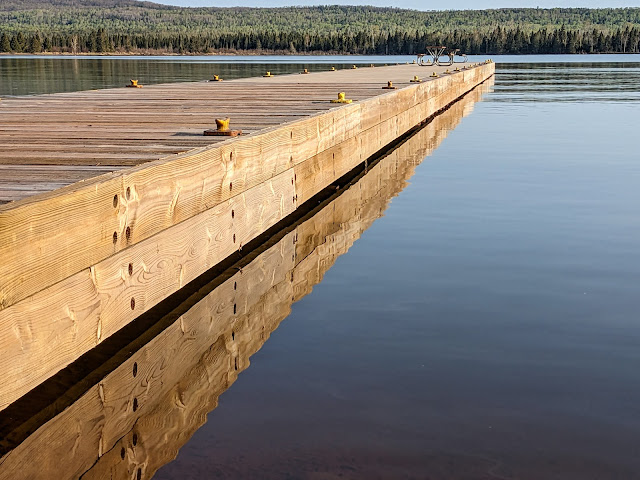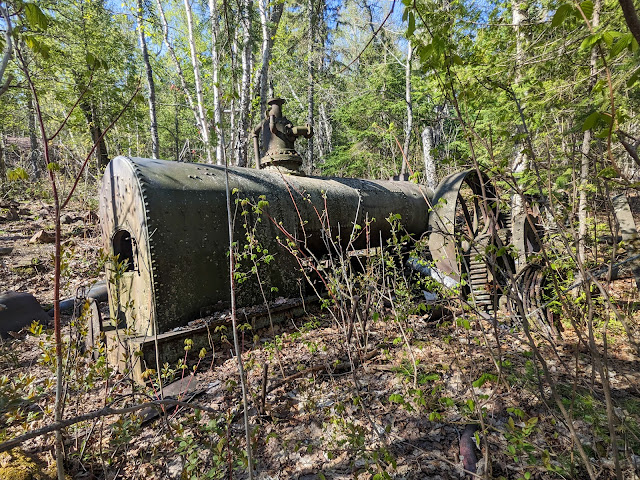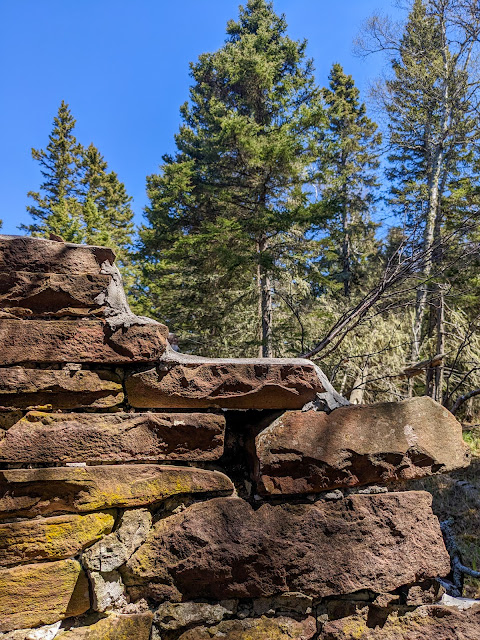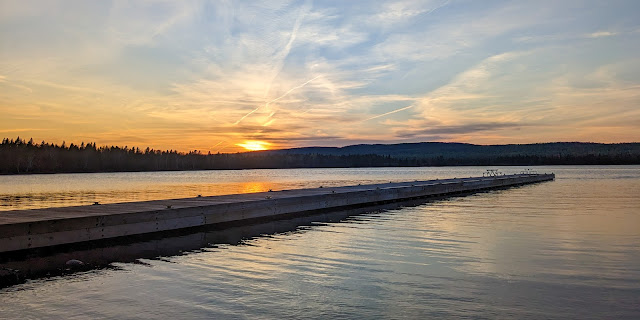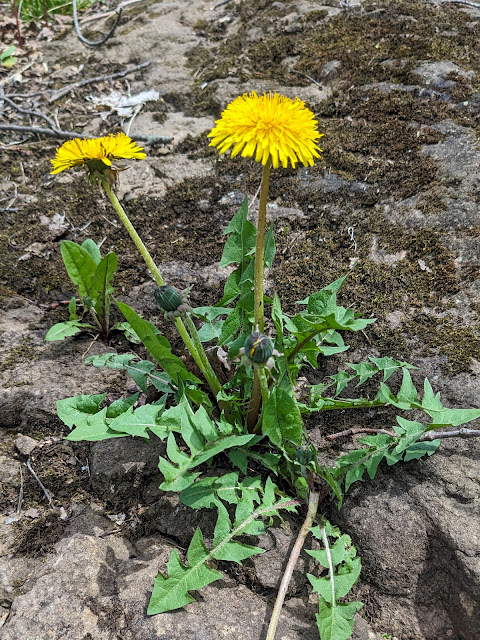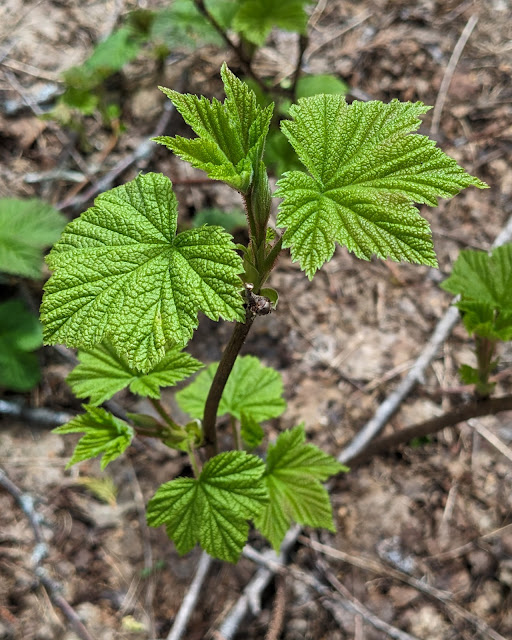Last time: A magic waterfall on the way to Feldtmann Lake - Links to all of my trip logs
 |
| Enjoying the beach at Feldtmann Lake |
Saturday May 27, 2023: The night was as warm as promised -- 40 degrees! -- and for the first time all trip I didn't wear a hat and puffy coat to bed. I still wore a thermal base layer and fleece, true, but who's counting?
When I woke up in the morning, I heard the same thing that I'd heard while going to sleep the night before: The distinctive thump-splish-splash of moose walking through shallow water. I crawled out of my tent and, sure enough, there were the same two young bulls, clomping back and forth along the beach. I walked along the campground trail (parallel to the beach) to watch them, when suddenly they came up into the campground and walked straight through site #2, whose occupant seemed to be completely asleep and unaware in his tent.
I excitedly told Sarah about this once she woke up. First we spared a thought for the three poor guys we'd met at Siskiwit Bay, who had complained that there were no moose at Feldtmann. They missed an entire moose parade by just one day!
But ever practical, Sarah's main question was: Has anybody packed up and left their site empty? Today was our self-imposed rest day, and any way to avoid spending it in the tiny, exposed site #3 would be good, even if it meant living in a moose highway. We took a look and found that the inhabitants of both sites #1 and #2 were now gone.
 |
| Wood Anemone |
We decided to move in to site #2, which seemed all around nicer. So it was that our tents levitated down the path, one of us at each end. Ah, the advantages of a modern lightweight tent! The new site was shady, spacious, and right next to the lake -- everything that site #3 was not.
After all of that, we finally enjoyed breakfast while sitting on a driftwood bench near the beach. The lake was again lovely and calm in the morning light. There were now three moose feeding down by the lake's outlet.
The rest of our morning was uneventful: We hung some stinky hiking clothes to air out on a clothesline, lounged around doing some reading, and had a lunch of rice cakes and peanut butter.
After lunch, we packed a daypack and headed down the trail to Rainbow Cove. We were promised that this short (0.8 mile) trail would lead us to the most amazing beach on Isle Royale -- a beautiful place of warm cobbles and amazing sunsets. We were just behind a large group who seemed to have some sort of very specific task that involved wandering off into the brush and measuring things.
 |
| Rainbow Cove's beach, featuring a napping Sarah |
The trail headed gradually downhill, generally following Feldtmann Lake's outlet stream (which, as far as I know, has no name). Along the way, we passed through many odd openings in the trees. They reminded me a bit of old homestead clearings, and sure enough, at one point I saw an old cookstove hiding in the trees. It probably wasn't from farmers -- the west exposure would have been horrible in the winter -- but perhaps fishermen once lived here? I don't know for sure.
Soon we came out to Rainbow Cove itself. It was... familiar. Other hikers had set our expectations high, and indeed, it was a lovely place. But if you've ever been to Calumet Waterworks or Agate Beach or Great Sand Bay (in one of its rockier seasons) on the Keweenaw, then you have also seen Rainbow Cove. Even Carnelian Beach, which we'd hiked just two days earlier along Siskiwit Bay, was pretty much the same. It's a beautiful red cobble beach made from the conglomerate that is absolutely ubiquitous in the Copper Country.
So we were perhaps a bit underwhelmed. But the beach was gorgeous, the sky was perfectly clear and blue, and there was the greatest lake in the world -- Superior! -- lapping right at our feet. So who were we to complain?
Our first task was to filter some cold Lake Superior water for future use. This involved both of us wading into the lake as far as we could go, which was about ankle-deep. The water was probably 38 degrees at most, and even in the hot sun, it hurt. While the filter ran, we put on sun block -- a lot of it -- and sat on a piece of driftwood. Then we kept sitting there, basking in the sun and reading. As we did, another Moosewatch group (or the same one? I have no clue) came down the trail, walked down to the stream's outlet, crossed it, and then disappeared into the brush along the lakeshore.
After a while, I got up and walked down the beach myself. The stream's outlet was cold and fast-running, and I waded across to see what I could see. The answer: More beach. I waded back and found that Sarah had burrowed into the rocks down near the water. The golf-ball-sized pebbles did a great job of conforming to her body. I tried it, and with a little wiggling and shuffling, the pleasantly warm rocks made a shallow form-fitting nest. I quickly had a small backrest set up and settled in to read. It was ideal: Warm sun and rocks, cool water just below our feet, beautiful views, and good books.
 |
| Feldtmann Lake's outlet stream at Rainbow Cove |
The Rock of Ages lighthouse -- which we'd first seen from the Feldtmann Ridge lookout -- was visible in the far distance. A variety of boats came and went across the shallow cove, never stopping, always on their way to somewhere else. The seaplane crossed the sky in front of us, and we waved. Less than 15 minutes later, the plane returned heading the other way. We waved again.
We spent three or four hours on the beach, finally calling it quits when it started to feel like dinnertime. While we'd started out a bit skeptical, Rainbow Cove had proved to be just as fantastic as promised. But make sure you visit Calumet Waterworks too, just to give yourself a comparison.
Back at camp, we took advantage of a luxury. We had left our "pocket shower" sitting out -- basically a large black water bag that does a nice job of absorbing heat from the sun. It had worked well on this sunny day. We hung it up around a tree and used it to give our hands and faces a scrub.
That was all well and good, but from there things went downhill. For in our absence, the bros had arrived.
"The bros" was our name for a collection of guys -- it's always guys -- who had arrived and set up in several open sites. They may or may not have been hiking together or even knew each other prior to arriving at camp, but somehow (pheromones? secret signs?) they had found each other and were now inseparable. Their key characteristic was to have a loud and expert-level opinion of every possible topic. They were loud enough to be heard across the campground, but that wasn't necessary, because they had packed fishing rods and were walking up and down the beach (and through our campsite) sharing their thoughts along the way. Their opinions were vast and varied. Gear and pack weight were favorite topics, as were lure choices, GPS and navigation apps, the proper kind of water bottle... anything and everything. Each statement used profanity like it was punctuation. "It f-ing slaps!" was used as an exclamation point.
On the upside, at least they weren't fellow Michiganders. I know this because they loudly wondered where they could buy marijuana now that they had arrived in Michigan (where it is legal). The short answer: Not in a national park.
We distracted ourselves by enjoying a dinner of freeze-dried something. My notes say lasagna, but my brain has no record of this. It was calories, not much more.
 |
| Moose through binoculars |
While much less exciting than moose, we also enjoyed a great deal of waterfowl drama that evening. Mergansers dove, the birds that went "meep" went "meep", and then a pair of geese started chasing away some uninvited guests, which involved an enormous amount of flapping and honking that echoed across the entire width of the lake.
Next time: Return of the Windigo - Links to all of my trip logs
Miles hiked: 1.6 (Rainbow Cove and back)
Total miles: 37.2



